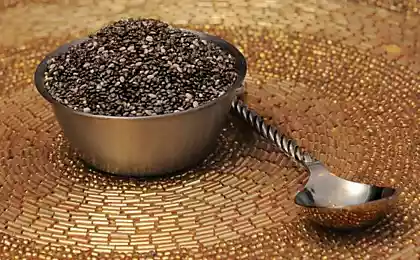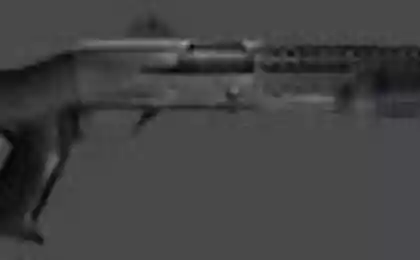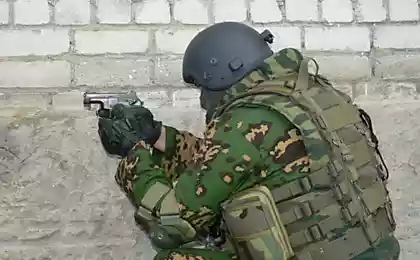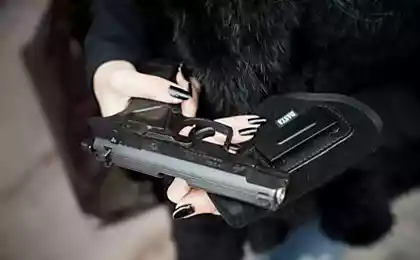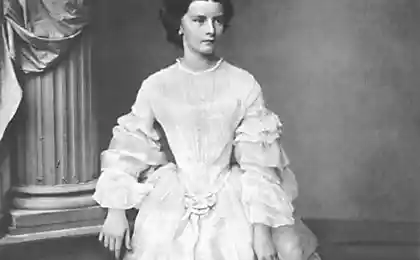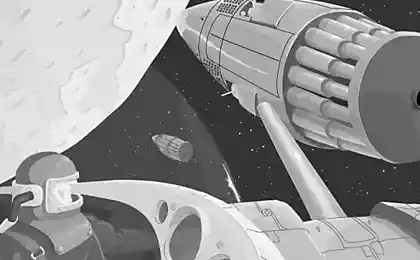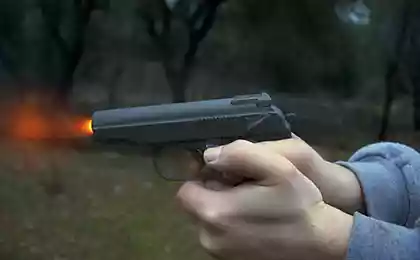1327
ISTOLET (fr. Pistolet, it. Pistole, from the Czech. Pist'ala - pipe or handguns)
10 ph + text
PISTOL (fr. Pistolet, it. Pistole, from the Czech. Pist'ala - pipe or handguns), individual firearms.
Pistols with wheel lock appeared in the 16th century., In the 17th century. spread guns with shock-flint castle in the 19th century. - A capsule. Before Ser. 19 in. pistols were usually smoothbore and were charged with the muzzle of the barrel. In the 50-ies. 19 in. guns in most armies gave way to more sophisticated weapons - rifled gun. The invention of smokeless powder (80th. 19 in.) And the use of a unitary cartridge with metal block. sleeve helped to create an automatic pistol with a higher rate of fire than the revolvers. With the advent of automatic pistols (1893) and their development in the 1st floor. 20. operated by the Army revolvers were gradually ousted.
Pistols are divided: to destination for combat, sports and signaling; by design - not on automatic and automatic (single and continuous fire).
1
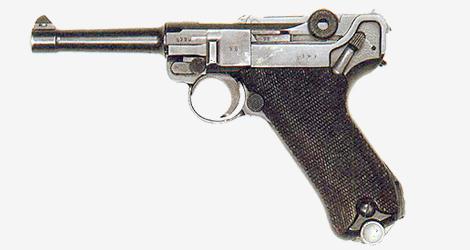
9mm pistol
Browning «High Power»
(Browning "High Power»)
Browning
1935
In 1927, J. death prevented. Browning personally convey to production model of its unquestionably a better gun. In the early 30-ies. XX century. this weapon, after some refinement, yet began to produce in factories in Belgium firm "Fabrique Nationale" called "Browning arr. 1935 ". Later this 9mm pistol was the proper name "High Power" and was adopted by the Belgian Army.
Automation of army pistol higher power working through the use of the recoil energy of the barrel when the short course. The main feature of the gun "High Power" became his store for the first time (for the store, which is located in the handle of the gun) was used two-row arrangement of cartridges with their single-row output. It is possible to increase the capacity to store a record for the value of the time - 13 rounds.
After the German occupation of Belgium (1940) plants of the company «Fabrique Nationale" began to produce guns "High Power" under the name of P-640 (b). During the years of World War II, part of the Wehrmacht and the SS have received more than 300 thousand. Units this pistol. The allied Romania were produced about 100 thousand. "High Power". In addition, the arms of German officers was adopted Browning pistol arr. In 1922, won the German title of P-626 (b). An interesting fact is that the Browning pistol arr. 1935 During World War II can be found bsho in the armies of many warring states. For example, the production of these weapons was held in Canada (which is a party to the anti-Hitler coalition) in the factories of the company «John Inglis." According to some reports, documentation for this gun was transferred to Canadians by employees of the company "Fabrique Nationale", who emigrated in 1940, Canadian "High Power" has officially arrived in the armies of Greece, Great Britain and China.
2
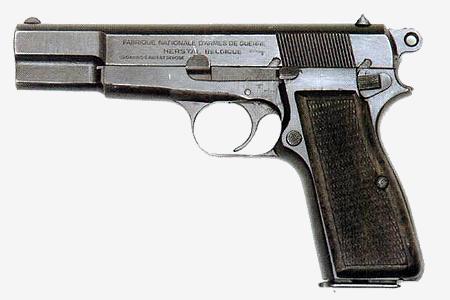
7, 63-mm gun
C-96 Mauser
(K-96 Mauser)
Federle
1896
In 1874, a German gunsmith Paul Mauser with the assistance of his older brother William founded the company in Oberndorf, called "Brothers Mauser and K °» (at the end of the XIX century. Was renamed "Vaffenfabrik Mauser AG," and in 1922 - in the "Mauser Werke AG"). For a long time the company products were rifles differed good quality and high enough GCB. The first gun was designed by P. Mauser only in 1893. However, its design was so original, that after two years has not lost its novelty. Therefore gunsmith decided to patent it. At the beginning of 1896 P. Mauser received a patent for a self-loading device 7-gauge, 63 mm gun with the sector, calculated on a distance of 1000 m. Automatic pistol built on the scheme with a moving trunk and sturdy locking bolt treasury at the time of the shot. Shutter gun had tetrahedral shape and could easily slide along the guide frame. The return spring housed inside the shutter and entwine around the striker. Trigger the gun was a hammer type, with an external (public) location trigger. Power pistol is from a non-removable store capacity th rounds. For loading ammunition store pre-placed in the plate holder, from which they then pushed into the gun.
The tests revealed a number of positive qualities pistol Mauser: reliability of action, even at low contamination and dust, high survivability (during the shooting of the models stood 10 thousand. Shots), good accuracy and a substantial rate (aimed fire 30 rds / min without sighting - 60 rds / min). For a submachine used 7, 63 mm bullets bottle-shaped bullet which had a high initial velocity. Limiting the range of a bullet is equal to 2000 m. From close range bullet weighing 5, 5 g punched ten 25 mm pine boards, but with 50 meters 10 bullets stacked in a rectangle of 160x120 mm.
At the same time construction of the gun it caused a lot of negative and responses. In particular this applies to a great length and a significant weapon weight, poor balancing (because the store placed in front of the trigger guard, the center of gravity of the gun turned out to be rendered far ahead), the inconvenience of loading store. These shortcomings have considerably limited the scope of the gun.
In the years preceding World War I, the gun Mauser mod. 1896 (in the literature can be found as the name of K-96) has undergone several upgrades, which, however, is not very influenced its design. In 1905, specially commissioned by the Italian government barrel shortened to 98mm, and the magazine capacity reduced to 6 rounds. This model went into service officers of the Navy of Italy. Later, this compact and powerful enough gun started to purchase Turkey and some European countries.
The most popular pre-war modification was released in 1912, returned Pistol 140 mm barrel, extended ejector box, set the fuse of a new design to reduce weight and several weapons. For the first time for pistols Mauser was mastered the production of two models - designed to use cartridges of caliber 7, 63x24 and 9x10 Mauser Parabellum. Soon, however, a 9-mm cartridges have become major in the German army, and since 1916 all guns Mauser (except for export models) were made under this cartridge.
After Germany's defeat in World War I, under the restrictions imposed on the weapons industry in the Treaty of Versailles, factories Mauser moved to produce small batches of guns mod. In 1896 with a barrel length of 98 mm, designed for the use of cartridges of caliber 7, 63x24 Mauser. They are used exclusively for police weapons, a limited number of army officers and exported. For example, in the late 20-ies. XX century. tens of thousands of 7, 63-mm Mauser pistols were purchased Soviet Russia for arming the Red Army officers and staff of the Cheka and the OGPU.
During the Second World War the SS troops and special units of the Wehrmacht used a limited number of pistols Mauser mod. 1896 of various modifications. The most common issue pistols were 1916-1918 years. chambered caliber 9x19 Parabellum. Also they participated in the battles of a small number of pistols Mauser mod. 1932 (model 712), of which it was possible not only to fire single shots, but the queues.
Serial production of the Mauser with shops located in front of the trigger guard, was discontinued in the late 30s. XX century. Later factories firm "Mauser Werke AG" moved to issue pistols classic layout, are popular for their high reliability.
3
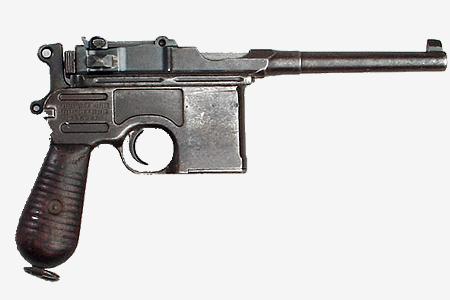
9mm pistol
P-08 «Parabellum»
(P-08 "Parabellum»)
Luger
1900
The gun is designed as an engineer of the company "Deutsche Waffen und Munitsionsfabriken" (DBL) by Georg Luger in 1900 as a result of design improvements Borchardt pistol arr. 1893 In 1901, this gun was named "pistol" derived from the telegraph address of the company "DVM" in Berlin, which in turn is a Latin expression "para bellum" - "prepare for war" (from the Latin proverb "If you want peace - prepare for war "). The gun is also sometimes called "Luger", but in the German army, he was awarded the official title of "Pistol 08" (P-08).
Mechanisms for automatic pistols operate using the recoil energy of the barrel with a short course of it. Like the gun Borchardt The barrel is locked Toggle gate. The pistol has a hammer mechanism striker type with separate mainspring mounted in the bolt. Trigger with disconnector designed for firing only single shots. Extraction of spent cartridges is carried situated in the gate ejector, which also serves as an indication of whether the cartridge in the chamber.
Safety lever is on the left side of the frame. When lowering the flag guard locked down the trigger and at the same time it is impossible to retraction of the barrel to the receiver.
Standing sight pistol designed for shooting at a distance of up to 50 m.
Stock is in the standard model P-08 is made of a removable box magazine capacity of 8 rounds. Used in the German army during the First World War, "artillery" model with a long barrel (LP-08) was completed store drum TM-08 with a capacity of 20 rounds (drum magazine was used together with a special box magazine of 12 rounds of ammunition, so that the total number of rounds was 32 pieces).
The length of the barrel "artillery" model used for the calculation of field weapons and land artillery and machine-gun, was 200 mm on the handle of the gun had a protrusion for attachment of the wooden butt - holster. Roll sight artillery model was designed for shooting at a distance of up to 800 m.
After the First World War due to the restrictions imposed by the Versailles Treaty, issued pistols "Parabellum" caliber 7, 65 mm, with a barrel length of 98 mm, but after 1934 the production of the standard model P-08 was recovered, and the beginning of the Second World War in parts of the Wehrmacht there were already more than 500 thousand. These pistols. Issue pistols P-08 lasted until 1942, when they were replaced in the production of more technological and less sensitive to contamination Walter pistol arr. 1938
In addition to the German army during the Second World War pistols P-08 operated by the army as Bulgaria, Greece, Finland, the Netherlands, Portugal and a number of the armies of other countries.
In 1970, the German company "Mauser-Yagdvaffen GmbH" has resumed production of "Parabellum" with length of barrels of 150 mm (caliber 7, 65 and 9 mm) and 100 mm (9 mm). These guns are designed for commercial sale.
4
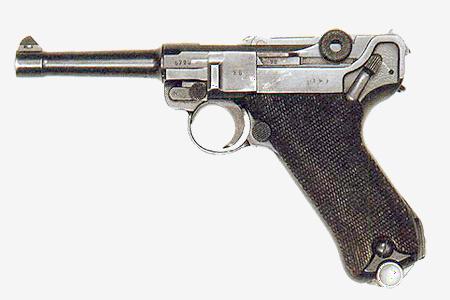
9mm pistol
P-38
(P-38)
Walter
1938
In April 1940, it has been adopted reliable and easy to manufacture Walther pistol arr. 1938 received the designation P-38.
Pistol P-38 refers to samples of automatic weapons, which is used to recharge the recoil energy of the barrel with a short course of it. The trigger mechanism of dual action allows the platoons and lower trigger single touch of the trigger. The trigger is open, his hand cocked provides Single effect when lightly pressed the trigger.
To protect against accidental firing gun has two fuse - external and internal (automatic). Flag External fuse installed on the left side of the shutter. To put a gun to the fuse box must be lowered down to align with the letter «F», the axis flag blocks firing pin, and then release the trigger with cocking. Internal fuse is located in a frame, it automatically prevents premature shot at an unlocked gate.
Gun for firing 9mm ammunition "pistol." Stock is made from removable box magazine capacity of 8 rounds. The magazine release is installed on the bottom of the handle.
To monitor the presence of a cartridge in the chamber has a pointer, which is located in the rear of the bolt on the trigger and in the presence of a cartridge in the chamber or sleeve protrudes.
Permanent open sight gun can fire at a range up to 50 m.
Pistol P-38 was manufactured until the end of the Second World War the three firms with the participation of several general contractors companies subcontractors. At the same time the company "Karl Walter Vaffenfabrik" produced 475 thousand. Pistols, the firm "Mauser" - 300 thous. And the firm "Shpreeverke GmbH" - 275 thousand.
During the Second World War, except for the German army pistol P-38 was in service with the Swedish Army only.
Discontinued after 1945 production of the P-38 pistol was restored in 1957 in a factory "Karl Walter Sportvaffenfabrik" in Ulm. Pistols arrived on arms of the newly created Army of Germany under the designation "P-1". Designed for the commercial sale of guns are marked "P-38". Currently, there are modified with a lightweight frame, designed for use cartridges .22LR and 9 mm and 7 mm 65 "pistol".
5
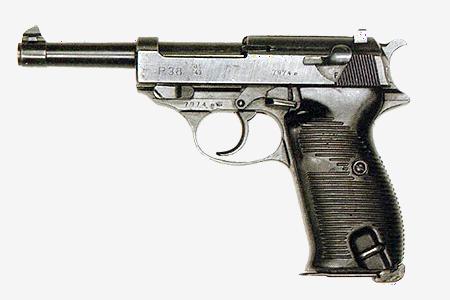
9mm pistol
Beretta
(Beretta)
1934
Already during the First World War, the Italian army has a very good 7, 65-mm (.32AKP) Self-loading Pistol "Beretta" arr. 1915
In 1934 has been adopted on its basis developed an improved gun, designed for firing 9mm ammunition. Automatic pistol of the sample in 1934 is operated by the recoil energy of free shutter. Located opened trigger gun can be cocked with the thumb of the hand holding the gun. With the same finger may be turned off on the left side frame safety that blocks the trigger.
The trigger mechanism of dual action allows firing only single shots. Stock is made from removable box magazine capacity of seven rounds. When fired, the casing with the shutter moves back while compressing the return spring and making the extraction of spent cartridges. Then, under the action of the return spring, he comes back, grabbing another and dosylaya chuck it into the chamber. Thus there is also cocked.
If cartridges run out, the shutter remains in the rear position. To reload the gun need to remove the empty magazine (the cover with the shutter thus returns to the forward position), insert a loaded magazine and pull the cover back to the gate to hand in these cartridge in the chamber and cock.
Pistol shooting carried out at a distance up to 40 m with a constant sight. Due to the strong return spring, absorbing a large part of the recoil, the gun is fairly stable while shooting. Increase of stability also contributes to a comfortable handle with plastic plates.
During the Second World War gun Beretta mod. 1934 was in service with the Italian Army. In aviation and the Navy used its option under the cartridge of caliber 7, 65 mm (pistol Beretta mod. 1935). There is also the option pistol with a silencer sound of a shot, absorbs about 80 percent of the strength of sound.
6

11, 43-mm gun
M1911 Colt
(Colt)
1911
The gun was adopted by the American cavalry and Navy before World War. After modernization in 1926 under the name M-1911A1 he entered service all the armed forces of the US Army. At the present time it is in service in more than 50 countries in the army, police and special units.
Automatic pistol operates on the principle of the recoil of the barrel with a short course of it. The barrel is locked by the protrusions top of the barrel which engages with grooves on the inner side of the slide. Trunk the pistol frame is connected via the mobile earrings ensuring locking and unlocking of the barrel.
Trigger trigger, single action trigger with an open arrangement. Drummer gun inertia. It is shorter than a channel in which moves and is spring-loaded. After hitting the hammer, he goes forward, hit the primer of the cartridge and then hide back in the channel.
The gun has two fuses - automatically turns off when the coverage of a hand, and the flag, which blocks the trigger and when the shutter.
The return spring is located under the barrel. Gun Sight open a pillar and flies. Cartridges are used for firing the .45 ACP.
7
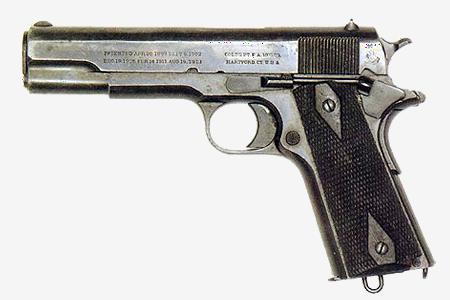
7, 62-mm gun
TT
Tokarev
1930
Despite the fighting qualities of Nagan revolver arr. 1895 more promising to arm the commanders of the Red Army was recognized by an automatic pistol.
8
9
10
Source:
PISTOL (fr. Pistolet, it. Pistole, from the Czech. Pist'ala - pipe or handguns), individual firearms.
Pistols with wheel lock appeared in the 16th century., In the 17th century. spread guns with shock-flint castle in the 19th century. - A capsule. Before Ser. 19 in. pistols were usually smoothbore and were charged with the muzzle of the barrel. In the 50-ies. 19 in. guns in most armies gave way to more sophisticated weapons - rifled gun. The invention of smokeless powder (80th. 19 in.) And the use of a unitary cartridge with metal block. sleeve helped to create an automatic pistol with a higher rate of fire than the revolvers. With the advent of automatic pistols (1893) and their development in the 1st floor. 20. operated by the Army revolvers were gradually ousted.
Pistols are divided: to destination for combat, sports and signaling; by design - not on automatic and automatic (single and continuous fire).
1

9mm pistol
Browning «High Power»
(Browning "High Power»)
Browning
1935
In 1927, J. death prevented. Browning personally convey to production model of its unquestionably a better gun. In the early 30-ies. XX century. this weapon, after some refinement, yet began to produce in factories in Belgium firm "Fabrique Nationale" called "Browning arr. 1935 ". Later this 9mm pistol was the proper name "High Power" and was adopted by the Belgian Army.
Automation of army pistol higher power working through the use of the recoil energy of the barrel when the short course. The main feature of the gun "High Power" became his store for the first time (for the store, which is located in the handle of the gun) was used two-row arrangement of cartridges with their single-row output. It is possible to increase the capacity to store a record for the value of the time - 13 rounds.
After the German occupation of Belgium (1940) plants of the company «Fabrique Nationale" began to produce guns "High Power" under the name of P-640 (b). During the years of World War II, part of the Wehrmacht and the SS have received more than 300 thousand. Units this pistol. The allied Romania were produced about 100 thousand. "High Power". In addition, the arms of German officers was adopted Browning pistol arr. In 1922, won the German title of P-626 (b). An interesting fact is that the Browning pistol arr. 1935 During World War II can be found bsho in the armies of many warring states. For example, the production of these weapons was held in Canada (which is a party to the anti-Hitler coalition) in the factories of the company «John Inglis." According to some reports, documentation for this gun was transferred to Canadians by employees of the company "Fabrique Nationale", who emigrated in 1940, Canadian "High Power" has officially arrived in the armies of Greece, Great Britain and China.
2

7, 63-mm gun
C-96 Mauser
(K-96 Mauser)
Federle
1896
In 1874, a German gunsmith Paul Mauser with the assistance of his older brother William founded the company in Oberndorf, called "Brothers Mauser and K °» (at the end of the XIX century. Was renamed "Vaffenfabrik Mauser AG," and in 1922 - in the "Mauser Werke AG"). For a long time the company products were rifles differed good quality and high enough GCB. The first gun was designed by P. Mauser only in 1893. However, its design was so original, that after two years has not lost its novelty. Therefore gunsmith decided to patent it. At the beginning of 1896 P. Mauser received a patent for a self-loading device 7-gauge, 63 mm gun with the sector, calculated on a distance of 1000 m. Automatic pistol built on the scheme with a moving trunk and sturdy locking bolt treasury at the time of the shot. Shutter gun had tetrahedral shape and could easily slide along the guide frame. The return spring housed inside the shutter and entwine around the striker. Trigger the gun was a hammer type, with an external (public) location trigger. Power pistol is from a non-removable store capacity th rounds. For loading ammunition store pre-placed in the plate holder, from which they then pushed into the gun.
The tests revealed a number of positive qualities pistol Mauser: reliability of action, even at low contamination and dust, high survivability (during the shooting of the models stood 10 thousand. Shots), good accuracy and a substantial rate (aimed fire 30 rds / min without sighting - 60 rds / min). For a submachine used 7, 63 mm bullets bottle-shaped bullet which had a high initial velocity. Limiting the range of a bullet is equal to 2000 m. From close range bullet weighing 5, 5 g punched ten 25 mm pine boards, but with 50 meters 10 bullets stacked in a rectangle of 160x120 mm.
At the same time construction of the gun it caused a lot of negative and responses. In particular this applies to a great length and a significant weapon weight, poor balancing (because the store placed in front of the trigger guard, the center of gravity of the gun turned out to be rendered far ahead), the inconvenience of loading store. These shortcomings have considerably limited the scope of the gun.
In the years preceding World War I, the gun Mauser mod. 1896 (in the literature can be found as the name of K-96) has undergone several upgrades, which, however, is not very influenced its design. In 1905, specially commissioned by the Italian government barrel shortened to 98mm, and the magazine capacity reduced to 6 rounds. This model went into service officers of the Navy of Italy. Later, this compact and powerful enough gun started to purchase Turkey and some European countries.
The most popular pre-war modification was released in 1912, returned Pistol 140 mm barrel, extended ejector box, set the fuse of a new design to reduce weight and several weapons. For the first time for pistols Mauser was mastered the production of two models - designed to use cartridges of caliber 7, 63x24 and 9x10 Mauser Parabellum. Soon, however, a 9-mm cartridges have become major in the German army, and since 1916 all guns Mauser (except for export models) were made under this cartridge.
After Germany's defeat in World War I, under the restrictions imposed on the weapons industry in the Treaty of Versailles, factories Mauser moved to produce small batches of guns mod. In 1896 with a barrel length of 98 mm, designed for the use of cartridges of caliber 7, 63x24 Mauser. They are used exclusively for police weapons, a limited number of army officers and exported. For example, in the late 20-ies. XX century. tens of thousands of 7, 63-mm Mauser pistols were purchased Soviet Russia for arming the Red Army officers and staff of the Cheka and the OGPU.
During the Second World War the SS troops and special units of the Wehrmacht used a limited number of pistols Mauser mod. 1896 of various modifications. The most common issue pistols were 1916-1918 years. chambered caliber 9x19 Parabellum. Also they participated in the battles of a small number of pistols Mauser mod. 1932 (model 712), of which it was possible not only to fire single shots, but the queues.
Serial production of the Mauser with shops located in front of the trigger guard, was discontinued in the late 30s. XX century. Later factories firm "Mauser Werke AG" moved to issue pistols classic layout, are popular for their high reliability.
3

9mm pistol
P-08 «Parabellum»
(P-08 "Parabellum»)
Luger
1900
The gun is designed as an engineer of the company "Deutsche Waffen und Munitsionsfabriken" (DBL) by Georg Luger in 1900 as a result of design improvements Borchardt pistol arr. 1893 In 1901, this gun was named "pistol" derived from the telegraph address of the company "DVM" in Berlin, which in turn is a Latin expression "para bellum" - "prepare for war" (from the Latin proverb "If you want peace - prepare for war "). The gun is also sometimes called "Luger", but in the German army, he was awarded the official title of "Pistol 08" (P-08).
Mechanisms for automatic pistols operate using the recoil energy of the barrel with a short course of it. Like the gun Borchardt The barrel is locked Toggle gate. The pistol has a hammer mechanism striker type with separate mainspring mounted in the bolt. Trigger with disconnector designed for firing only single shots. Extraction of spent cartridges is carried situated in the gate ejector, which also serves as an indication of whether the cartridge in the chamber.
Safety lever is on the left side of the frame. When lowering the flag guard locked down the trigger and at the same time it is impossible to retraction of the barrel to the receiver.
Standing sight pistol designed for shooting at a distance of up to 50 m.
Stock is in the standard model P-08 is made of a removable box magazine capacity of 8 rounds. Used in the German army during the First World War, "artillery" model with a long barrel (LP-08) was completed store drum TM-08 with a capacity of 20 rounds (drum magazine was used together with a special box magazine of 12 rounds of ammunition, so that the total number of rounds was 32 pieces).
The length of the barrel "artillery" model used for the calculation of field weapons and land artillery and machine-gun, was 200 mm on the handle of the gun had a protrusion for attachment of the wooden butt - holster. Roll sight artillery model was designed for shooting at a distance of up to 800 m.
After the First World War due to the restrictions imposed by the Versailles Treaty, issued pistols "Parabellum" caliber 7, 65 mm, with a barrel length of 98 mm, but after 1934 the production of the standard model P-08 was recovered, and the beginning of the Second World War in parts of the Wehrmacht there were already more than 500 thousand. These pistols. Issue pistols P-08 lasted until 1942, when they were replaced in the production of more technological and less sensitive to contamination Walter pistol arr. 1938
In addition to the German army during the Second World War pistols P-08 operated by the army as Bulgaria, Greece, Finland, the Netherlands, Portugal and a number of the armies of other countries.
In 1970, the German company "Mauser-Yagdvaffen GmbH" has resumed production of "Parabellum" with length of barrels of 150 mm (caliber 7, 65 and 9 mm) and 100 mm (9 mm). These guns are designed for commercial sale.
4

9mm pistol
P-38
(P-38)
Walter
1938
In April 1940, it has been adopted reliable and easy to manufacture Walther pistol arr. 1938 received the designation P-38.
Pistol P-38 refers to samples of automatic weapons, which is used to recharge the recoil energy of the barrel with a short course of it. The trigger mechanism of dual action allows the platoons and lower trigger single touch of the trigger. The trigger is open, his hand cocked provides Single effect when lightly pressed the trigger.
To protect against accidental firing gun has two fuse - external and internal (automatic). Flag External fuse installed on the left side of the shutter. To put a gun to the fuse box must be lowered down to align with the letter «F», the axis flag blocks firing pin, and then release the trigger with cocking. Internal fuse is located in a frame, it automatically prevents premature shot at an unlocked gate.
Gun for firing 9mm ammunition "pistol." Stock is made from removable box magazine capacity of 8 rounds. The magazine release is installed on the bottom of the handle.
To monitor the presence of a cartridge in the chamber has a pointer, which is located in the rear of the bolt on the trigger and in the presence of a cartridge in the chamber or sleeve protrudes.
Permanent open sight gun can fire at a range up to 50 m.
Pistol P-38 was manufactured until the end of the Second World War the three firms with the participation of several general contractors companies subcontractors. At the same time the company "Karl Walter Vaffenfabrik" produced 475 thousand. Pistols, the firm "Mauser" - 300 thous. And the firm "Shpreeverke GmbH" - 275 thousand.
During the Second World War, except for the German army pistol P-38 was in service with the Swedish Army only.
Discontinued after 1945 production of the P-38 pistol was restored in 1957 in a factory "Karl Walter Sportvaffenfabrik" in Ulm. Pistols arrived on arms of the newly created Army of Germany under the designation "P-1". Designed for the commercial sale of guns are marked "P-38". Currently, there are modified with a lightweight frame, designed for use cartridges .22LR and 9 mm and 7 mm 65 "pistol".
5

9mm pistol
Beretta
(Beretta)
1934
Already during the First World War, the Italian army has a very good 7, 65-mm (.32AKP) Self-loading Pistol "Beretta" arr. 1915
In 1934 has been adopted on its basis developed an improved gun, designed for firing 9mm ammunition. Automatic pistol of the sample in 1934 is operated by the recoil energy of free shutter. Located opened trigger gun can be cocked with the thumb of the hand holding the gun. With the same finger may be turned off on the left side frame safety that blocks the trigger.
The trigger mechanism of dual action allows firing only single shots. Stock is made from removable box magazine capacity of seven rounds. When fired, the casing with the shutter moves back while compressing the return spring and making the extraction of spent cartridges. Then, under the action of the return spring, he comes back, grabbing another and dosylaya chuck it into the chamber. Thus there is also cocked.
If cartridges run out, the shutter remains in the rear position. To reload the gun need to remove the empty magazine (the cover with the shutter thus returns to the forward position), insert a loaded magazine and pull the cover back to the gate to hand in these cartridge in the chamber and cock.
Pistol shooting carried out at a distance up to 40 m with a constant sight. Due to the strong return spring, absorbing a large part of the recoil, the gun is fairly stable while shooting. Increase of stability also contributes to a comfortable handle with plastic plates.
During the Second World War gun Beretta mod. 1934 was in service with the Italian Army. In aviation and the Navy used its option under the cartridge of caliber 7, 65 mm (pistol Beretta mod. 1935). There is also the option pistol with a silencer sound of a shot, absorbs about 80 percent of the strength of sound.
6

11, 43-mm gun
M1911 Colt
(Colt)
1911
The gun was adopted by the American cavalry and Navy before World War. After modernization in 1926 under the name M-1911A1 he entered service all the armed forces of the US Army. At the present time it is in service in more than 50 countries in the army, police and special units.
Automatic pistol operates on the principle of the recoil of the barrel with a short course of it. The barrel is locked by the protrusions top of the barrel which engages with grooves on the inner side of the slide. Trunk the pistol frame is connected via the mobile earrings ensuring locking and unlocking of the barrel.
Trigger trigger, single action trigger with an open arrangement. Drummer gun inertia. It is shorter than a channel in which moves and is spring-loaded. After hitting the hammer, he goes forward, hit the primer of the cartridge and then hide back in the channel.
The gun has two fuses - automatically turns off when the coverage of a hand, and the flag, which blocks the trigger and when the shutter.
The return spring is located under the barrel. Gun Sight open a pillar and flies. Cartridges are used for firing the .45 ACP.
7

7, 62-mm gun
TT
Tokarev
1930
Despite the fighting qualities of Nagan revolver arr. 1895 more promising to arm the commanders of the Red Army was recognized by an automatic pistol.
8
9
10
Source:



